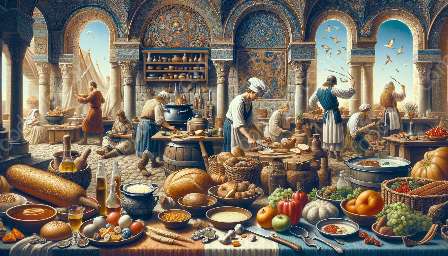Food preservation has been essential throughout human history, particularly in ancient and medieval times when preserving food was crucial for survival. Various methods were employed to extend the shelf life of perishable goods, influenced by the culinary practices and food culture of the times. Let’s delve into the fascinating world of ancient and medieval food preservation methods, exploring their impact on culinary practices and cultural history.
Ancient Food Preservation Methods
Ancient civilizations devised innovative techniques to preserve food without modern technologies. The availability of resources and climatic conditions played a significant role in shaping the preservation methods of each culture.
Salting
One of the oldest methods of preserving food, salting involves coating or immersing food in salt. Ancient civilizations, such as the Egyptians, Greeks, and Romans, used salt to preserve meat, fish, and vegetables. The preservation process involves drawing moisture out of the food, thereby inhibiting the growth of bacteria and microorganisms that cause spoilage.
Drying
Drying food under the sun or in open-air environments was a prevalent preservation method in ancient times. The Egyptians, for example, dried fish and dates, while the Mesopotamians used sun-drying for fruits and vegetables. The lack of moisture inhibits the growth of bacteria, allowing food to be stored for extended periods.
Fermentation
Fermentation, particularly the process of lacto-fermentation, was commonly used in ancient times to preserve vegetables, fruits, and dairy products. The anaerobic environment created during fermentation inhibits the growth of harmful bacteria while also enhancing the nutritional value and flavor of the preserved food.
Pickling
Ancient civilizations, including the Greeks and Romans, preserved various food items through pickling in vinegar or brine. This method not only extended the shelf life of foods but also infused them with unique flavors, contributing to the diversity of ancient culinary practices.
Medieval Food Preservation Methods
The medieval period saw the continuation of ancient preservation methods and the introduction of new techniques influenced by trade, exploration, and advancements in culinary arts.
Smoking
Smoking was widely practiced in medieval Europe to preserve meats, fish, and cheese. The process of exposing food to smoke from burning wood not only imparts distinct flavors but also inhibits microbial growth, maintaining the edibility of the preserved items.
Pickling and Preserving in Alcohol
The medieval era witnessed the refinement of pickling methods, particularly in the use of alcohol, such as wine and beer, to preserve fruits and meats. This technique not only extended the shelf life of food but also imbued them with unique flavors, adding depth to medieval culinary creations.
Curing
In medieval times, curing was a popular method for preserving meats, especially pork. The process involves treating meat with salt and spices, followed by a period of cold smoking. This method not only preserved the meat but also enhanced its flavor and texture, contributing to the evolution of medieval gastronomy.
Food Preservation and Culinary Practices
The preservation methods of ancient and medieval times influenced culinary practices in profound ways. Preserved foods often served as essential provisions for long journeys, military campaigns, and winter seasons, shaping the development of portable and hearty dishes. Additionally, the use of preserved ingredients in daily cooking expanded culinary horizons, leading to the creation of diverse and flavorful dishes.
Cultural Significance
Food preservation methods held cultural significance in ancient and medieval societies, reflecting the intricate relationship between food, culture, and history. These methods were often passed down through generations, becoming integral to traditional cuisines and culinary heritage. Furthermore, the trade and exchange of preserved foods among different cultures facilitated the sharing of culinary traditions and the fusion of diverse flavors.
Conclusion
The exploration of ancient and medieval food preservation methods provides invaluable insights into the ingenuity and resourcefulness of our ancestors. These methods not only sustained populations but also enriched culinary practices and cultural heritage. Understanding the historical context of food preservation enhances our appreciation for traditional cuisines and the profound impact of preservation techniques on human civilization.

